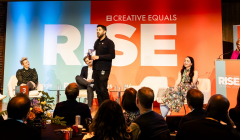
Are we leaving men and boys behind?
At Creative Equal’s RISE event, industry leaders consider how to reframe boys and men in marketing

The ad industry should be well prepped for the introduction of regulation and look toward the opportunities

When it comes to the government’s HFSS regulations there has been much collective wringing of hands within the ad industry – not helped by the constant will it/won’t it happen, as ministers change their minds and the chaos of world events continues to ensue. Despite much preparation on the part of brands and retailers, the cost-of-living crisis was the hook on which the government finally chose to delay regulations until October 2023.
But regardless of the delay, before the ad industry throws their arms up in panic about the HFSS ruling, I'd like to pose the idea that regulation can actually be beneficial for creativity.
Constraints can be a powerful source of inspiration, forcing you to think in different ways and break out of set patterns.
Algy Sharman, Chief Creative Officer, Joint
Constraints can be a powerful source of inspiration, forcing you to think in different ways and break out of set patterns. Some of the UK’s best advertising has been born out of restrictions applied to different sectors. For example, car advertising’s bar on showing speeding cars ultimately led to the hugely successful Honda Cog advert, while beer brands not being able to show worse-for-wear revellers produced Guinness Surfer. The list goes on.
It goes without saying that advertising is about standing out. Therefore, you need to earn a consumer's attention in different and imaginative ways. Showing people something they don’t expect is quite simply the best way to be remembered.
Restrictions for advertisers mean that they have to work even harder to break through. It prevents lazy advertising and forces creatives to look for different ways to develop an interesting angle. Working around a problem, delving into the heart of what motivates audiences. Working with a strategy that comes at the brand from a different perspective is when creativity thrives and the most emotionally resonant work is made.
There will be long-term benefits for the brands that put this effort into their campaigns, and they are much more likely to stand the test of time. The Honda and Guinness examples look as fresh today as they did when they first aired.
Restrictions might also give smaller brands a better chance against the big brand names and level the playing field. Big advertisers all too often take the easy shortcuts, revert to norms, churn out default advertising and simply outspend everyone with massive media budgets – relying on the vain hope that if they hit people over the head enough times with the same average advertising, they’ll eventually submit and buy their products. This ad fatigue is the reason that consumer love for advertising is currently at an all time low. Instead, the best creative – rather than the biggest budget – will win.
Who would you prefer to buy from at a market stall? Someone who shouts in your ear about something you don’t care about? Or someone who engages you in easy conversation, makes you laugh perhaps? Then lets you make the decision if the thing they have on offer is something you’d like to buy or not? You’d think the answer is obvious, but switch on the TV and I challenge you not to turn the volume down when the ads come on, or switch channels all together. It’s all just brands shouting stuff at you that you don’t care about.
Advertising needs to entertain you, engage you in a conversation, then maybe, just maybe, you’ll listen. And maybe, just maybe, you’ll think about that brand again the next time you’re walking down a supermarket aisle.
So, if regulation means a brand has to entertain their customers in new and interesting ways to cut through, then it could actually be a force for good.
Rather than worrying about government regulations, or praying we’ll see another delay, we could actually see them as an opportunity to make something great.
In the words of my former boss, John Hegarty, “Give me the freedom of a tight brief.” Let’s all embrace the freedom of restriction.
Algy Sharman is Chief Creative Officer at Joint
Looks like you need to create a Creativebrief account to perform this action.
Create account Sign inLooks like you need to create a Creativebrief account to perform this action.
Create account Sign in